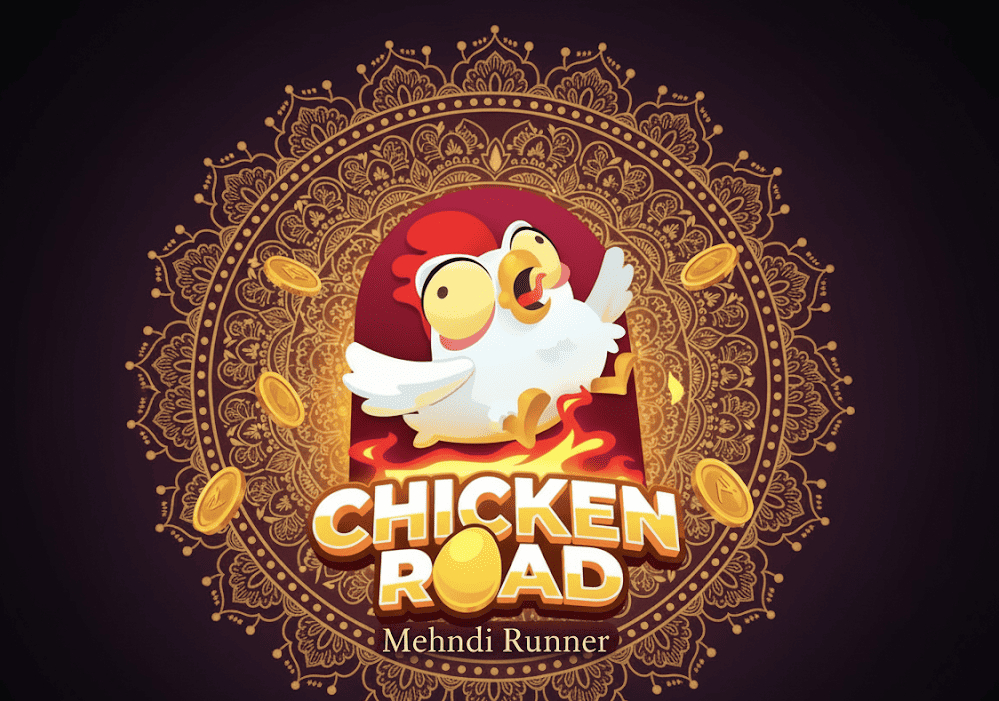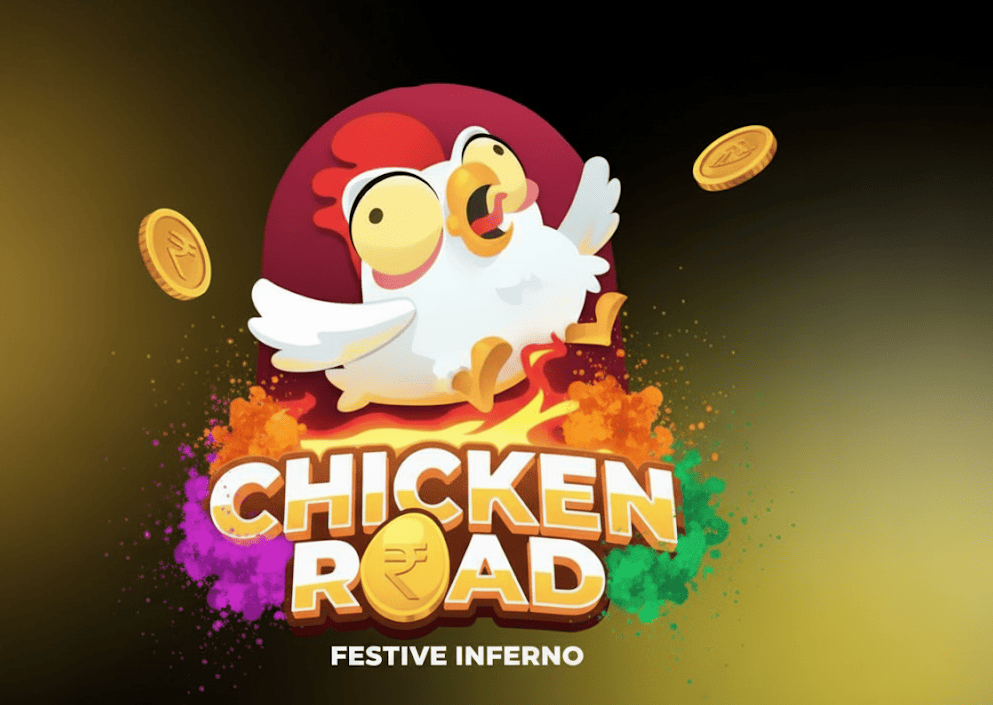Chicken Road India — Fast Gameplay, Clear Decisions
A mobile crash game designed for short sessions and disciplined exits

Chicken Road compresses casino play into seconds. A round starts, the chicken dashes forward, and the multiplier climbs.
The tension builds with every tick: exit early for safety, or hold for a higher return.
Unlike slots or card games, nothing distracts from the decision window — it is pure timing.
This simplicity is why the game feels natural for Indian players who prefer light, quick sessions on mobile.
Each choice carries weight, yet every new round resets the stage, offering another chance to refine discipline.
The design removes clutter: multiplier center screen, stake controls at the base, and a single cash-out action in reach.
Auto-exit provides structure while manual taps add flexibility during longer climbs.
For players in India, where 4G and 5G connections differ across regions, the lightweight build ensures stable play
without heavy data usage. The result is a focused experience — clear, responsive, and adaptable.
Tip: treat the first ten rounds as practice. Use smaller stakes, fix one exit target,
and only adjust after consistency feels natural. This habit protects your bankroll
and builds confidence under time pressure.
Chicken Road — Core Mechanics for Fast, Mobile-First Play
Each round in Chicken Road follows a clean loop built for quick Indian sessions: a short prep window, a dash, a rising multiplier, and a stop.
All attention stays on one choice — when to exit. This is why the interface keeps controls minimal and within thumb reach on phones.
You can run a single stake or split your approach with two independent stakes, set an auto-exit for discipline, and still retain manual control for late changes.
The system is light on data, starts fast even on mixed 4G/5G, and resets in seconds, which fits short breaks during commutes or evenings.
The essentials below map what happens between the countdown and the finish.
Use them to set a repeatable routine: configure stake size before the timer ends, predefine a safe exit, and only adjust targets after a quick review of the last few rounds.
Treat history as tempo awareness rather than a predictor.
When the multiplier climbs smoothly, keep to plan; when crashes are frequent, scale stakes down and shorten exits to conserve the bankroll.
| Phase | Player Action | On-Screen Focus | Practical Outcome |
|---|---|---|---|
| Countdown | Set stake(s), define auto-exit | Stake panel, preset buttons | Plan fixed exits before the dash begins |
| Start | Confirm bet, avoid last-second edits | Clear timer, bet confirmation | Clean entry prevents misclicks |
| Climb | Watch multiplier, hold or exit | Live multiplier bar | Manual exit remains available |
| Auto-Exit | Let preset lock results | Auto trigger indicator | Removes reflex pressure |
| Finish | Round ends, review briefly | Result line, history feed | Adjust targets only if needed |
Quick routine: ten low-stake rounds with a fixed exit, then add a second, smaller stake aimed higher.
Keep stake sizes constant for a full set before changing anything.
Timing and Exit Psychology in Chicken Road
Chicken Road is not only a game of numbers but also a test of emotional control.
Each second the chicken keeps running, tension increases, and the temptation to “wait a little longer” grows.
For players in India, where many sessions are short and played in busy environments, the challenge is to stick to a plan despite these psychological pulls.
The strongest results come not from prediction but from consistency: preparing exits before the countdown, respecting those targets, and avoiding last-second changes.
Common emotions arise in almost every session: fear after quick crashes, greed when multipliers climb smoothly, frustration from a series of losses, or overconfidence after a win streak.
Recognizing these states early prevents them from steering your decisions.
Indian players often use small routines — pausing for one round, lowering stakes, or taking notes — to reset focus.
The table below highlights the most frequent emotions, their effects, and how to manage them effectively.
| Emotion | When It Appears | Effect on Play | How to Manage |
|---|---|---|---|
| Fear | After consecutive quick crashes | Too-early exits, minimal gains | Set auto exits and trust them |
| Greed | During smooth multiplier climbs | Holding beyond safe targets | Write exits in advance; avoid changes mid-run |
| Frustration | After multiple losses in a row | Sudden stake increases | Pause for one or two rounds, reset stake size |
| Confidence | Following several wins | Aggressively raising stakes | Keep units flat until full session ends |
| Excitement | During rare long flights | Forgetting bankroll limits | Use small side stake for high multipliers only |
Routine suggestion: log results every 10 rounds. Patterns in mood often reveal more than patterns in multipliers.
Adjust your strategy based on how you feel, not on imagined sequences.
Bankroll Management for Consistent Chicken Road Play
A clear bankroll plan is the strongest defense against fast-paced errors in Chicken Road.
Because each round ends in seconds, small impulses can repeat and empty balances quickly.
Indian players often prefer short sessions of 10–20 minutes, making it even more important to divide funds
into units and treat each round as part of a structured cycle. Flat staking — keeping stake size the same for a block of rounds —
prevents both reckless increases after losses and overconfidence after wins.
The core principle is unit management: split your bankroll into 20 or more units, and never risk more than one unit per round.
This system stretches gameplay, reduces stress, and builds time for disciplined exits.
Experienced players sometimes mix smaller and larger units, but beginners should focus on consistency first.
A quick checklist helps prepare before each session.
- Decide the maximum spend for a session (no more than 10% of your balance).
- Divide the deposit into equal units, risk one unit per round.
- Keep stake size constant for at least 10 consecutive rounds.
- Pause after 15–20 rounds to review results.
- Record exits and multipliers for trend awareness.
| Bankroll | Stake Size | Estimated Rounds | Suggested Approach |
|---|---|---|---|
| ₹500 | ₹20–₹30 | 15–20 | Focus on early exits (1.20×–1.40×) |
| ₹1,000 | ₹40–₹80 | 20–25 | Mix safe and mid-range exits (~2×) |
| ₹2,500 | ₹100–₹150 | 30–40 | Include dual bets with a small high target |
| ₹5,000+ | ₹200–₹300 | 40+ | Layered strategy: safe baseline + occasional risks |
Strong bankroll habits extend playtime and lower stress.
Treat stake sizes as fixed rules for each block of rounds.
Adjust only after reviewing results between sessions, never in the middle of one.
Play Styles in Chicken Road — Finding Your Approach

Every Chicken Road session looks different depending on your chosen play style. Some players focus on safe exits and steady returns,
while others chase high multipliers for thrill and occasional big wins. In India, where many sessions are short and mobile-based,
choosing a style that matches your goals and schedule is essential. A clear label for your approach helps prevent impulsive changes mid-session
and gives structure to your bankroll plan. Below are the four most common profiles, with strengths and weaknesses outlined.
- Conservative: exits at 1.20×–1.40×, low risk, frequent small wins, but rarely catches big multipliers.
- Balanced: exits at 2×–3×, medium risk, solid mix of stability and excitement, good for daily sessions.
- Aggressive: targets 5×–10×, high risk, occasional large wins but bankroll swings are common.
- Extreme: holds above 20×, very high risk, rare dramatic wins, long waits between successes.
| Style | Exit Range | Risk | Strength | Weakness |
|---|---|---|---|---|
| Conservative | 1.20×–1.40× | Low | Steady balance growth | Misses high multipliers |
| Balanced | 2×–3× | Medium | Good mix of wins and safety | Moderate variance, no extremes |
| Aggressive | 5×–10× | High | Chance for larger payouts | Frequent losses |
| Extreme | 20×+ | Very High | Rare dramatic wins | Highly inconsistent |
Choosing a style is about comfort as much as ambition. Decide whether you prefer safe and steady returns or
the adrenaline of rare multipliers. Stick to your label for one session before experimenting with another.
Dual Bets in Chicken Road — Two Parallel Exits, One Round

Dual bets let you run two independent stakes in the same Chicken Road round. The first stake usually locks a modest
multiplier to keep the session stable; the second stake waits longer to capture a rarer climb. In India, where many
players hop in for short mobile sessions, this split is practical: one exit pays the routine, the other hunts the highlight.
The key is pre-round planning. Decide targets during the countdown, keep stake sizes consistent across several rounds,
and avoid changing exits mid-flight unless you have a clear rule for doing so.
A reliable structure is to label the stakes. Stake A is the anchor: early auto-exit between 1.25× and 1.60×.
Stake B is the scout: manual exit in the 3×–6× window, with room to stretch during calm streaks. If a short crash
appears, Stake A reduces damage; if the curve extends, Stake B is in position. Over time, this pairing narrows variance
while preserving upside. Keep amounts modest on Stake B to limit drawdowns, and review results every 20–30 rounds
rather than after each flight.
- Label exits before takeoff and repeat the same plan for a fixed sample of rounds.
- Use auto-exit on Stake A to remove reflex pressure; keep Stake B manual for flexibility.
- Avoid increasing both stakes after a big win; scale only one, and only after a review.
- Pause one round after an unusual spike to reset timing and prevent chasing behavior.
| Stake A (Anchor) | Stake B (Scout) | When to Use | Risk Profile | Session Effect |
|---|---|---|---|---|
| Auto 1.25×–1.40× | Manual 3×–4× | Daily short sessions on mobile | Low–Medium | Frequent small returns with occasional boosts |
| Auto 1.30×–1.60× | Manual 5×–7× | Balanced evening play | Medium | Smoother variance; good mix of outcomes |
| Manual 1.50×–2× | Manual 8×–12× | Experienced timing, stable connection | Medium–High | Higher peaks with disciplined exits |
| Auto 1.20× | Manual 15×+ | Tournament-style practice | High | Sharp swings; keep B stake small |
A compact rule set works well on phones: A = auto-exit safety, B = manual reach. If the round ends early,
your anchor softens the impact; if it stretches, your scout captures distance. Consistency across many rounds
is more important than any single result.
Multiplier Rhythms in Chicken Road — Setting Realistic Expectations
Each Chicken Road round is independent, but over time patterns in multiplier frequency emerge.
Most flights end early, many stabilize in mid ranges, and only a few stretch into dramatic climbs.
Recognizing this rhythm helps players in India align goals with reality: focus sessions on common exits,
treat mid-range wins as the backbone of bankroll growth, and accept long spikes as occasional bonuses.
Chasing rare events is a fast way to exhaust a balance; disciplined exits within frequent ranges create sustainability.
The table below summarizes general multiplier bands, how often they appear, what risk they carry,
and sample payouts for a ₹100 stake. Use this as a practical framework, not as prediction.
It highlights why steady exits around 1.20×–3× work as daily anchors and why targets above 20×
should be attempted sparingly, with very small stake sizes.
| Multiplier Range | Frequency | Risk Level | Sample Payout (₹100) | Notes |
|---|---|---|---|---|
| 1.10× – 1.50× | Very Common | Low | ₹110 – ₹150 | Best for beginners |
| 2.00× – 3.00× | Common | Medium | ₹200 – ₹300 | Reliable session anchor |
| 5.00× – 10.00× | Occasional | High | ₹500 – ₹1,000 | Use small stakes only |
| 20× + | Rare | Very High | ₹2,000+ | Treat as bonus, not target |
Plan exits in the ranges that appear most often. Small gains repeated consistently
outweigh rare but risky attempts at extreme multipliers.
Discipline turns rhythm into structure.
Common Mistakes in Chicken Road — And How to Avoid Them
Fast games like Chicken Road magnify small errors because rounds reset in seconds. Without structure,
players repeat the same mistake multiple times in one session. In India, where many people play during
short breaks, discipline is even more important. The most frequent errors are not technical but behavioral:
staying too long on a run, raising stakes after a loss, or trusting myths about pattern prediction.
Awareness of these traps and replacing them with clear rules is the first step toward sustainable play.
Below is a checklist of mistakes and their solutions. Treat it as a reference before each session.
By converting these points into habits, you reduce stress, extend playtime, and increase the chances
of steady growth instead of rapid balance swings.
- Holding beyond planned exits — Set auto-exit values and stick to them.
- Doubling stakes after losses — Keep unit size flat for at least 10 rounds.
- Skipping breaks — Pause every 15–20 rounds to reset focus.
- Believing history predicts results — Treat history feed only as tempo context.
- All-in bets — Never risk more than 5–10% of total bankroll per round.
- Chasing rare 20×+ multipliers — Use small side stakes for high-risk attempts.
- Increasing stakes after wins — Maintain structure, review only between sessions.
- Ignoring connection quality — Play on stable networks to ensure exits trigger on time.
| Mistake | Impact | Correction |
|---|---|---|
| Waiting too long | Missed exits, frequent losses | Plan conservative exits, trust auto settings |
| Stake chasing after a miss | Rapid bankroll decline | Flat staking across all rounds |
| Ignoring breaks | Loss of focus, bad timing | Pause and review every 15–20 rounds |
| All-in strategy | One mistake ends session | Never exceed 10% bankroll per round |
Habit replaces impulse. Review this checklist before starting, and repeat it until
exits, stakes, and pauses become second nature. Mistakes won’t vanish, but their cost will shrink.
Community Play and Mini-Tournaments in India
Beyond individual play, Chicken Road has grown into a social experience across India.
Players often gather online or in small groups to compare exits, celebrate rare multipliers,
and run informal competitions. This community element turns quick rounds into shared events.
With short formats and low stakes, mini-tournaments give structure to sessions and introduce
a sense of friendly rivalry. They also help new players learn by observing how others plan exits
and manage bankrolls in real time.
Indian players often organize these tournaments during weekends or festivals, aligning with cultural habits
of social gaming and celebration. Formats vary: some focus on longest safe streaks, others reward
the boldest successful holds. Even without official leaderboards, the shared excitement builds a sense of
community around Chicken Road that extends beyond the app itself. The table below highlights common types of
community play, their rules, and what players gain from them.
| Format | Rules | Reward | Activity Level |
|---|---|---|---|
| Friendly Duels | Two players compare exits over 10 rounds | Bragging rights | Daily casual play |
| Mini Challenges | Reach a target multiplier (e.g., 5×) first | Small gifts or snacks | Weekly |
| Weekend Cups | 50 rounds tracked for average exit | Shared prize pool | High |
| Festival Specials | Holiday events with themed rounds | Large pooled rewards | Very High |
Community sessions add more than prizes — they build habits.
Watching how peers manage exits teaches discipline, and friendly rivalry makes each round more engaging.
For many Indian players, this social factor is what transforms Chicken Road into a shared tradition.
Chicken Road India — Frequently Asked Questions
New players often ask similar questions before starting Chicken Road. To simplify navigation,
the FAQ below provides concise answers on gameplay, exits, bankroll, and mobile performance.
Expand each item to read more details and apply them in your sessions.
How long does one round last?
A single round usually takes between 5–15 seconds. After the chicken stops, a new countdown begins immediately,
ensuring fast session flow without waiting.
Can I set auto-exit points?
Yes. Auto-exit allows you to predefine a multiplier (e.g., 1.30×). The system locks your stake at that value automatically,
reducing the pressure of reacting manually each round.
What is the best exit strategy for beginners?
Beginners should target early exits between 1.20×–1.50×. These multipliers appear often,
help protect the bankroll, and build confidence before experimenting with higher risks.
Does internet speed affect results?
A stable connection is crucial. While the game is lightweight, sudden drops in network speed can delay exit signals.
On mobile networks in India, it is best to use auto-exit as backup to protect against lag.
Can dual bets reduce risk completely?
No. Dual bets balance safety and ambition but cannot remove risk entirely. Stake A secures modest exits,
while Stake B aims higher. The total exposure still needs to respect bankroll rules.
What bankroll size is good for starters?
A starting bankroll of ₹500–₹1,000 split into small units is sufficient. Risk one unit per round and plan
exits conservatively to stretch playtime across at least 15–20 rounds.
Final Thoughts on Chicken Road in India
Chicken Road condenses the essence of crash gameplay into short, focused sessions that fit perfectly with mobile-first habits in India.
Each round is fast, every decision matters, and the discipline to exit on time separates steady players from impulsive ones.
With clear bankroll rules, structured exits, and awareness of emotional triggers, the game becomes more than chance — it becomes a controlled rhythm of play.
Community challenges, dual bets, and practical mobile tips add depth, while the simplicity of the interface keeps focus sharp.
For newcomers and regulars alike, the key is consistency: repeat a plan, log results, and keep each session within safe limits.
Use the insights from this guide to shape your own routine.
Start with low stakes, pick a style, and grow into more advanced strategies only after you build confidence.
Treat rare multipliers as bonuses, not goals, and focus on the steady ranges that appear most often.
This balance of patience and action is what makes Chicken Road a sustainable and exciting part of modern mobile gaming in India.
